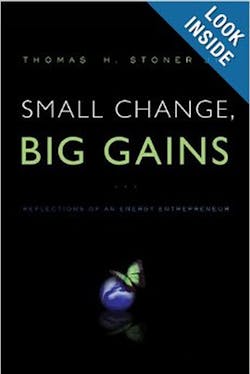A recently released paperback from energy entrepreneur Thomas Stoner might be worth a look for those who are interested in how sustainability can blend into real-world economics. In Small Change, Big Gains, Stoner gives a thorough background on the business of energy production and floats a few ideas for developing business plans around climate change.
Stoner, a London School of Economics graduate, has good credentials for writing this 517-page tome. He was involved in founding the Social Venture Network, a nonprofit organization billed as catering to socially responsible business leaders interested in sustainability. Stoner also founded two different energy companies. One, Econergy International, was a big developer of renewable energy projects, including wind farms, small hydro, and methane fired power generation facilities. Econergy also was a major trader of carbon credits under the Kyoto Protocol. Currently, he chairs the board of Evergreen Energy Inc., known for its K-fuel clean coal process.
If you are not completely up to date on world CO2 levels, ocean temperature maps, peak oil theories, and other energy data, the first part of the book serves as a good overview. One nit, though, is that Stoner relies a lot on data from the IEA and the U.S. Energy Administration, both of which have taken flak about the reliability of their numbers.
Stoner picks up steam when he starts talking about Project Butterfly, an idea that seems to have been inspired by clean-up efforts aimed at the Chesapeake Bay near the Washington, D.C. area. Basically, Stoner advocates taking what happened on the Chesapeake Bay and scaling it up to a global effort. “Although the arrangement is controversial, supports of CBF (Chesapeake Bay Foundation) in the past have put a value on the bay by valuing the local commerce,” Stoner writes. “In making such a claim about the value of the Chesapeake, supporters of CBF are suggesting that investments in upgrades to wastewater treatment, improvements in storm water infrastructure, and the implementation of agricultural conservation practices are not simple costs required to save a species of fish or to make it possible for us to swim in the bay. Rather, the supporters of CBF have made the radical argument that such investments directly create local jobs and contribute to urban and rural planning that is fundamental to the creation and preservation of financial value and wealth.”
Expand this concept and you get the idea of where Stoner is headed. If you don’t like carbon credits and carbon taxes, you’ll probably not like his drift.
Still, the fact that these ideas come from a guy who is intimately familiar with the energy industry make them worth considering.
About the Author
Lee Teschler
Editor
Leland was Editor-in-Chief of Machine Design. He has 34 years of Service and holds a B.S. Engineering from the University of Michigan, a B.S. Electrical Engineering from the University of Michigan;, and a MBA from Cleveland State University. Prior to joining Penton, Lee worked as a Communications design engineer for the U.S. Government.
